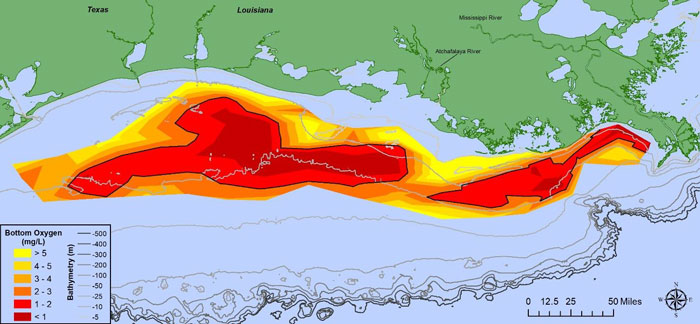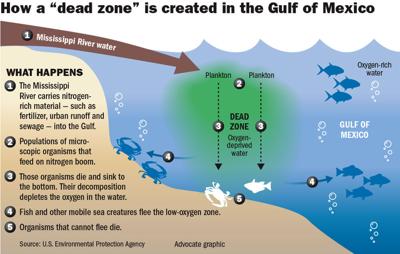I guess a dead zone is part of the ocean that can´t survive. I heard about dead zones from a Ted Talk called Nancy Rabalais: The ¨dead zone¨ of the Gulf of Mexico. Ms. Rabalais is a Marine scientist that works for the US government who says she ¨owes it¨ to US citizens to tell them about dead zones. She explains that in the Gulf of Mexico there is an area where all the oxygen is being used up by the microorganisms. If there is not any oxygen, then the sea creatures can´t survive. She compared the size of the dead zone to New Jersey, which is 8,729 square miles. That sounds big even for a small state. The Ted Talk was from 2017. In 2019 the National Oceanic and Atmospheric Administration (NOAA) reports the dead zone is now the size of Massachusetts. Massachusetts is 10,565 square miles. In two years the dead zone has grown massively. I hope scientists can shrink the dead zone before it gets to be the size of California.

In 2019 Scientists show how massive the dead zone is in the Gulf of Mexico.
The dark red area presents where there is the least amount of oxygen for the sea creatures.
Rabalais claims small steps can help on farms, where the problem starts near the Mississippi River. Farmers use fertilizers on their land. When it rains the fertilizer washes into the river and ends up in the Gulf of Mexico. She agrees with the NOAA that humans are making the dead zones. The fertilizers make the microorganisms grow in the gulf. When they die they sink to the bottom and then kills the oxygen where some sea creatures live. If the farmers stop growing corn or use fewer chemicals, then there will be fewer fertilizers in the water. Rabalais is not a farmer, so she tries not to eat meat, not use corn oil or drive a car that uses ethanol gas.

The white crab and fish had died because they didn't have enough oxygen.

The white crab and fish had died because they didn't have enough oxygen.
I hope the scientist can tell farmers to protect the sea creatures because they´re just as important as farm animals. I will be in New Jersey next week for Thanksgiving. If I remember, I will tell my relatives about the dead zone comparison to New Jersey, and I won't eat corn because I don't like it.
"The Dead Zone of the Gulf Mexico ." YouTube , uploaded by Ted Talks, Google , 2017, www.ted.com/talks/nancy_rabalais_the_dead_zone_of_the_gulf_of_mexico#t-703456. Accessed 22 Nov. 2019.
Hardy, Steve. "'Large to very large' Gulf of Mexico dead zone expected this year; Here's what caused it." theadvocate.com, The Advocate, 16 May 2019, www.theadvocate.com/baton_rouge/news/environment/article_b28f1bd0-77e7-11e9-a33d-97289e73dd28.html. Accessed 22 Nov. 2019.
LUMCON. "Map ." 2019. Earth Sky, 16 Aug. 2019, earthsky.org/earth/dead-zone-gulf-of-mexico-2019 . Accessed 22 Nov. 2019.
Slaff, Jerry. "NOAA forecasts very large 'dead zone' for Gulf of Mexico." NOAA , 12 June 2019, www.noaa.gov/media-release/noaa-forecasts-very-large-dead-zone-for-gulf-of-mexico. Accessed 22 Nov. 2019.
LUMCON. "Map ." 2019. Earth Sky, 16 Aug. 2019, earthsky.org/earth/dead-zone-gulf-of-mexico-2019 . Accessed 22 Nov. 2019.
Slaff, Jerry. "NOAA forecasts very large 'dead zone' for Gulf of Mexico." NOAA , 12 June 2019, www.noaa.gov/media-release/noaa-forecasts-very-large-dead-zone-for-gulf-of-mexico. Accessed 22 Nov. 2019.
It's worrying that the dead zone has increased in size even with the increase in media coverage about it. Have any farmers/farms taken steps to prevent their impact on the size of the dead zone?
ReplyDelete